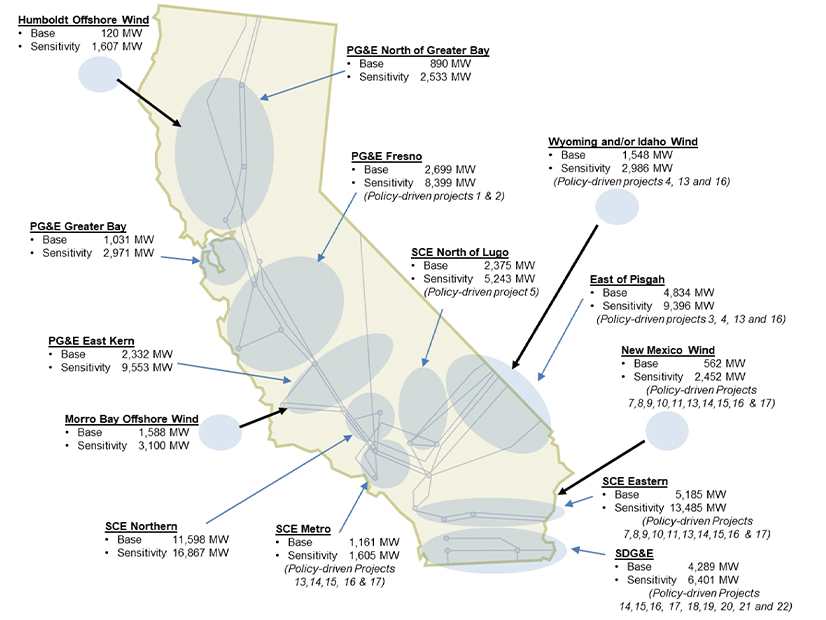
CAISO published a draft transmission plan Monday that identifies 46 transmission projects needed over the next decade to incorporate more than 40 GW of renewable resources essential for advancing the state’s transition to 100% clean energy and maintaining grid reliability.
“The need for additional generation of electricity over the next 10 years has escalated rapidly in California as it continues transitioning to the carbon-free electrical grid required by the state’s clean-energy policies,” CAISO said in the plan. “This in turn has been driving a dramatically accelerated pace for new transmission development in current and future planning cycles.
“To help ensure we have the transmission in place to achieve this transition reliably and cost-effectively, the ISO’s 2022-2023 Transmission Plan reflects a much more strategic and proactive approach to better synchronize power and transmission planning, interconnection queuing and resource procurement,” the plan says.
The more proactive approach was outlined in a memorandum of understanding that CAISO, the California Public Utilities Commission (CPUC) and the California Energy Commission (CEC) signed in December. It provided a “new blueprint for our state” with closer links between the planning processes of each entity, CAISO CEO Elliot Mainzer told the ISO Board of Governors in February. (See CAISO CEO Lauds Transmission Planning Agreement.)
The new transmission plan is the first to be prepared under the MOU.
It is based on the CPUC’s projections that the state needs to add at least 40 GW of new resources by 2032 in a base-case scenario and 70 GW in a “sensitivity” scenario “reflecting the potential for increased electrification occurring in other sectors of the economy, most notably in transportation and the building industry,” the plan says.
“The network upgrades are recommended in this plan to make all of the base amounts available and, in Southern California, to also make most of the sensitivity amounts available as well,” it says.
The CPUC has already indicated it will provide the 70GW scenario as its base case next year, so the “remaining network upgrades needed to achieve the sensitivity amounts will be approved next year” in CAISO’s annual update to its 10-year transmission plan.
Interconnection Zones
In preparing the plan, CAISO analyzed projected resource additions within 14 transmission interconnection zones. The Southern California Edison (SCE) Northern zone, for example, will need 11.6 GW of new resources under the base case scenario and 16.9 GW under the sensitivity portfolio, primarily through a buildout of utility-scale solar and battery storage.
Critical resources identified in the plan include:
- 17 GW of solar generation in the deserts of Southern California and the Central Valley, and in areas of Nevada and Arizona.
- 3.5 GW of in-state wind generation.
- 1 GW of geothermal development in the Imperial Valley of far Southern California and in southern Nevada.
- Battery storage projects co-located with renewable generation projects and stand-alone storage near Los Angeles, San Francisco and San Diego.
- 4.5 GW of in-state transmission upgrades necessary to import out-of-state wind energy from Idaho, Wyoming and New Mexico.
- 3-5 GW of wind generation off the coast of Central California.
“To achieve these outcomes, the ISO has found the need for a total of 46 transmission projects, the vast majority of which would be built in California. They range in projected costs from $4 million to $2.3 billion, for a total infrastructure investment of an estimated $9.3 billion,” CAISO said.
Major projects include a new 500-kV transmission line from the Arizona border to Imperial County, a new 500 kV transmission line from southern Imperial County to San Diego and the Los Angeles Basin, and upgrades to existing 500-kV and 230-kV lines along the Interstate 10 corridor, which runs from Los Angeles toward Phoenix.
“Together, these upgrades provide access to east Riverside County, Imperial County and Arizona solar generation, Imperial Valley geothermal, and New Mexico wind generation,” the transmission plan says.
Other notable projects include a new 500-kV transmission line from southeastern Nevada to the Los Angeles Basin and “rebuilding of existing southeastern Nevada 230-kV transmission inside the ISO to 500 kV, providing access for Eldorado and Pisgah area solar generation, southeastern Nevada solar and geothermal generation, and Wyoming and Idaho wind generation.”
‘Next Major Installment’
CAISO identified 24 reliability-driven projects, totaling $1.76 billion and 22 policy-driven projects needed to meet the state’s climate goals, totaling $7.53 billion.
In addition, the ISO has been working with out-of-state transmission developers to bring wind from Wyoming via the planned TransWest Express line and from New Mexico via the planned Sunzia line to the CAISO boundary.
Developers for the transmission projects have sold capacity on their lines to “resource developers seeking to access California markets,” the plan says. “That work is ongoing, and the timing of those projects is driven by the developers and their subscribers.”
CAISO said it had also studied the need for transmission for North Coast offshore wind based on the sensitivity portfolio provided by the CPUC.
“As the study was only informational and set the stage for future planning, no projects were recommended for approval in this 2022-2023 plan,” it said. But with “growing volumes” of offshore North Coast wind identified in the CPUC’s 2023/24 planning cycle, the “ISO expects to make a decision on North Coast transmission in next year’s transmission plan.”
In a blog post, Mainzer said the 2022/23 transmission plan “represents the next major installment of infrastructure investment required to meet California’s long-term clean energy goals. In close coordination with regulatory agencies, load-serving entities and other key stakeholders, we endeavored to address the state’s reliability and policy needs in the most cost-effective and efficient way possible.”
CAISO has scheduled a stakeholder meeting April 11 to discuss the draft plan and expects to seek approval from its Board of Governors in May.
